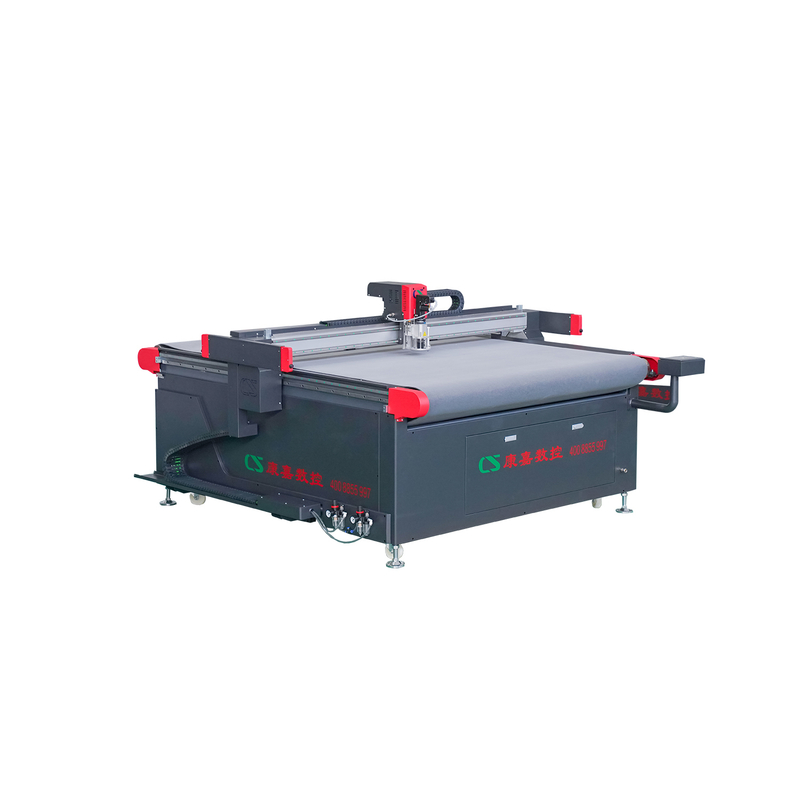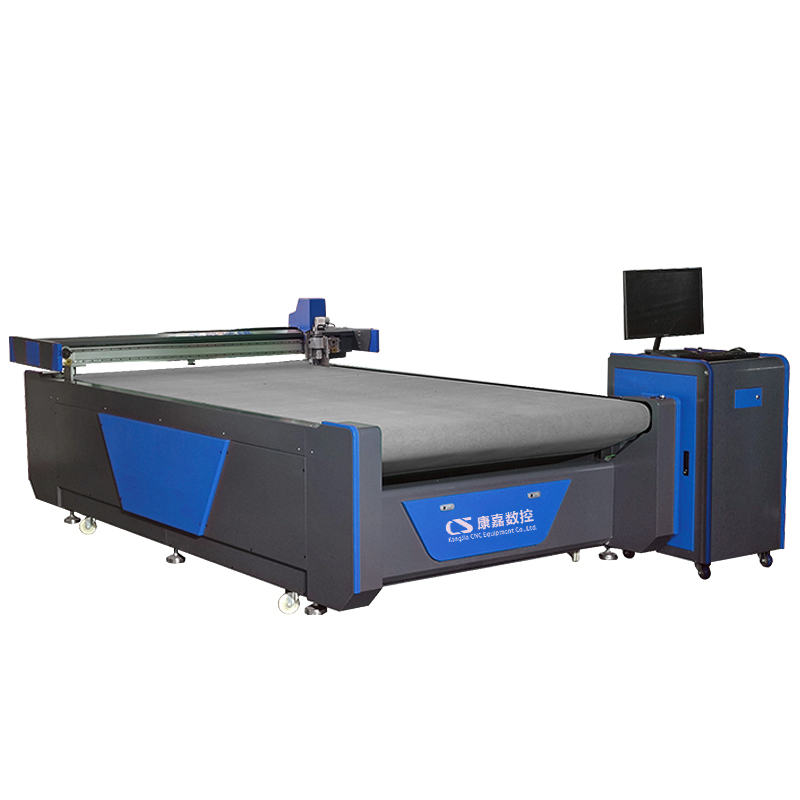Views: 0 Author: Site Editor Publish Time: 2025-10-22 Origin: Site








In the rapidly evolving world of manufacturing, precision is paramount, especially in leather and fabric cutting. Digital cutting machines have emerged as game-changers, offering unmatched accuracy and efficiency that traditional methods simply cannot match. With the ability to achieve sub-millimeter precision, these advanced tools not only enhance the quality of cuts but also significantly reduce material waste. This article explores how digital cutting machines are revolutionizing the cutting process, ensuring that manufacturers can meet the demands of modern production while maintaining high standards of quality and sustainability.
Digital cutting machines bring a new level of precision to leather and fabric cutting. Unlike traditional methods, these machines achieve sub-millimeter accuracy, meaning cuts are made within fractions of a millimeter. This precision is crucial when working with complex patterns or expensive materials like leather, where even a tiny mistake can ruin the piece.
Digital cutters use highly accurate motors and control systems to guide the cutting tool along exact paths. This level of control ensures every cut matches the design perfectly. Whether cutting curves, angles, or intricate shapes, the machine maintains consistent precision across the entire material. This accuracy reduces errors and saves costly materials.
Modern digital cutting machines incorporate advanced sensors and laser-guided systems to enhance accuracy further. Sensors detect the material’s position and thickness, allowing the machine to adjust cutting depth and pressure in real time. Laser guidance helps align the cutting path precisely, preventing deviations caused by fabric stretch or movement. These technologies work together to produce flawless cuts every time.
The high precision of digital cutting machines directly improves product quality. Cuts are clean, edges are smooth, and patterns fit together perfectly during assembly. This consistency is vital for industries like fashion, automotive, and furniture, where quality standards are strict.
Moreover, precise cutting reduces material waste significantly. Fewer mistakes mean less scrap, which lowers costs and benefits the environment. Optimized cutting paths enabled by accurate sensors also maximize material use, further minimizing waste.
Invest in digital cutting machines equipped with laser guidance and sensors to ensure consistent accuracy and reduce costly material waste in your production.

Digital cutting machines shine in their ability to handle a wide variety of fabrics and leathers. Whether you work with delicate silk, stretchy spandex, thick genuine leather, or synthetic materials like vinyl, these machines adapt effortlessly. This adaptability makes them a valuable asset across multiple industries.
Each material has unique properties—some stretch, others are rigid; some are thin, others thick. Digital cutters adjust cutting speed, blade pressure, and path based on the material type. For example:
● Silk and delicate fabrics: The machine uses gentle pressure and slower speeds to avoid damage.
● Leather: Oscillating or laser blades cut through tough, thick hides cleanly without fraying.
● Stretch fabrics: Sensors detect tension and adjust cuts to prevent distortion.
This flexibility eliminates the need for multiple cutting tools or machines, streamlining production.
Because of their material versatility, digital cutting machines serve many sectors:
● Fashion and Apparel: From casual wear to couture, they cut patterns precisely on various textiles.
● Automotive: Leather and synthetic fabrics for seats, dashboards, and door panels require exact cuts for perfect fits.
● Furniture: Upholstery materials, including leather and fabric, benefit from consistent cutting to ensure quality finishes.
This broad application means manufacturers can invest in one machine to cover many needs.
In fashion, the ability to cut complex patterns on different fabrics speeds up design changes and small batch runs. Automotive manufacturers gain from precision cuts that reduce waste and improve assembly fit. Furniture makers enjoy consistent upholstery cuts that enhance product durability and appearance.
By handling many materials, digital cutting machines reduce tool changes, cut setup time, and operator training. This versatility leads to higher productivity and lower production costs.
Choose digital cutting machines with adjustable blade and pressure settings to efficiently handle diverse materials across industries, boosting your production flexibility and reducing downtime.
Digital cutting machines dramatically boost production speed in leather and fabric cutting operations. These machines eliminate many delays common in manual cutting, allowing businesses to meet tight deadlines and high demand efficiently.
Manual cutting often slows production due to the need for skilled labor and careful handling. Workers must measure, mark, and cut each piece by hand, which takes time and risks errors. Digital cutting machines remove these steps by automating the entire process. Once the design is uploaded, the machine cuts precisely and quickly without breaks or fatigue. This automation reduces bottlenecks and speeds up workflow significantly.
Digital cutters excel at handling large volumes of material. Many models can cut multiple layers simultaneously, multiplying output without sacrificing accuracy. This ability is vital for businesses that require mass production, such as apparel manufacturers or automotive suppliers. The machines operate continuously, maintaining consistent speed and quality over long runs. Their rapid cutting cycles help companies scale production while controlling costs.
In fast-paced industries, speed is crucial to stay competitive. High-demand environments like fashion seasons, automotive assembly lines, or furniture manufacturing benefit greatly from faster cutting processes. Digital cutting machines help meet tight delivery schedules and respond quickly to market changes. Their efficiency reduces lead times, allowing businesses to fulfill orders faster and improve customer satisfaction.
Invest in digital cutting machines capable of multi-layer cutting and continuous operation to maximize throughput and meet high production demands efficiently.
Digital cutting machines play a vital role in reducing material waste during leather and fabric cutting. One of the key technologies driving this efficiency is nesting software, which optimizes how patterns are arranged on the material to use as much surface area as possible.
Nesting software automatically arranges cutting patterns to fit tightly together, minimizing gaps and unused spaces. It analyzes the shapes and sizes of pieces, then places them in a way that reduces scrap material. This process can increase material utilization by 10% to 15% or more, depending on the complexity of the patterns and the type of material. The software also considers fabric grain, stretch direction, and defects, ensuring patterns align correctly and avoid flaws.
By using nesting technology, manufacturers can:
● Reduce leftover scraps significantly
● Avoid costly re-cuts caused by inefficient layouts
● Save time by automating pattern placement instead of manual arrangement
Reducing waste directly translates into cost savings. Leather and high-quality fabrics are expensive, so maximizing usage lowers raw material expenses. Less waste means fewer materials need purchasing, boosting profit margins. Additionally, cutting less scrap reduces disposal costs and environmental impact. This supports sustainability efforts, a growing priority in many industries.
Efficient material use helps companies meet eco-friendly standards and appeal to environmentally conscious customers. By adopting digital cutting machines with advanced nesting software, businesses contribute to waste reduction and resource conservation.
Beyond nesting, digital cutting machines maintain precise cutting paths that prevent overlapping or excessive margins between pieces. The machines adjust blade pressure and speed to avoid damaging the material edges, ensuring every usable inch counts. Some systems even detect fabric defects or inconsistencies, automatically repositioning patterns to avoid flawed areas.
This combination of intelligent software and precise hardware maximizes material yield and minimizes errors. It enables manufacturers to produce more parts from the same amount of material, improving overall efficiency and sustainability.
Implement digital cutting machines with advanced nesting software to optimize pattern layout, reduce scrap, and achieve significant cost savings while supporting sustainable production practices.
Digital cutting machines offer unmatched customization and flexibility, transforming how manufacturers approach leather and fabric cutting. Unlike traditional methods requiring physical templates or dies, digital cutters rely on software-driven designs, allowing rapid adaptation to new patterns and styles.
With digital cutting, switching to a new design takes just a few clicks. Designers upload CAD files directly to the machine, which instantly adjusts cutting paths accordingly. This eliminates the time-consuming process of creating new physical templates or molds, speeding up product development cycles. It also enables quick responses to market trends, letting brands stay ahead with fresh styles.
For example, a fashion company can introduce seasonal collections faster by cutting new patterns without downtime. This agility supports innovation and helps meet customer demands promptly.
Digital cutters excel at producing small batches, making them ideal for custom or limited-edition products. Traditional cutting often involves costly setup for each batch, which is inefficient for low volumes. Digital machines, however, require minimal setup, enabling economical runs of small quantities.
This flexibility benefits businesses offering personalized products or testing new designs before mass production. It reduces inventory risks and allows more experimentation without significant cost increases.
Compared to manual or die-cutting techniques, digital cutting machines provide several advantages:
● No physical tooling needed: Saves time and money on creating and storing dies or templates.
● Instant design changes: Software updates replace physical adjustments.
● Higher accuracy on complex shapes: Software-guided cuts handle intricate patterns consistently.
● Lower setup costs: Ideal for both small and large production runs.
● Faster turnaround: Cuts production lead times drastically.
These benefits combine to make digital cutting machines indispensable for modern manufacturers aiming for flexibility and efficiency.
Leverage digital cutting machines to quickly adapt to design changes and efficiently produce small batches, reducing costs and accelerating your time to market.

Digital cutting machines greatly reduce labor costs by cutting down on manual work. These machines operate mostly on their own, needing just a little human input to start and monitor the process. This means companies can rely less on skilled cutters, who are often hard to find and expensive to hire.
Manual cutting requires workers to measure, mark, and cut materials carefully. This slows production and increases the chance of mistakes. Digital machines automate these steps, cutting materials precisely without breaks or fatigue. Operators simply load designs into the system, and the machine handles the rest. This automation cuts down on labor hours and reduces errors caused by human fatigue or distraction.
Labor costs are not just about wages; they also include costs related to rework and waste from inconsistent cutting. Digital cutters maintain accuracy across every piece, ensuring uniform quality. This consistency means fewer defective parts, lowering the need for re-cuts and saving time and money. The machines’ precise operation reduces supervision needs, freeing up staff for other tasks.
By automating cutting, companies can shift their workforce to more complex or value-added roles. Instead of spending time on repetitive cutting, employees can focus on quality control, finishing, or design improvements. This better use of human resources boosts overall productivity and job satisfaction.
Use digital cutting machines to automate repetitive tasks, reduce reliance on skilled manual labor, and let your team focus on higher-value production activities.
Digital cutting machines enhance precision in leather and fabric cutting, ensuring consistent quality and reducing waste. They streamline production, increase speed, and lower labor costs, benefiting industries like fashion, automotive, and furniture. As technology advances, these machines will continue to revolutionize manufacturing processes. Businesses are encouraged to adopt this cutting-edge technology for improved efficiency and sustainability. Companies like Jinan Kangjia CNC Equipment Co., Ltd offer advanced machines that provide unmatched accuracy and flexibility, delivering significant value to manufacturers.
A: Digital Cutting Machines are advanced tools that use precise motors and sensors to cut materials like leather and fabric with high accuracy.
A: Digital Cutting Machines automate the cutting process, eliminating manual delays, and can handle large volumes quickly, boosting production speed.
A: Digital Cutting Machines use nesting software to optimize pattern layout, reducing scrap and maximizing material utilization.
A: They adjust blade pressure and speed based on material type, allowing them to cut a wide range of fabrics and leathers efficiently.
